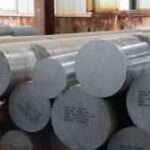Introduction

In the realm of precision manufacturing, the choice of materials plays a pivotal role in determining the quality, durability, and cost-effectiveness of the final product. One such material that has gained significant attention is 1045 cold rolled steel. Renowned for its versatility, strength, and machinability, 1045 cold rolled steel has become a cornerstone in various precision manufacturing processes. This blog aims to delve deeper into the characteristics, applications, and advantages of 1045 cold rolled steel in precision manufacturing.
Characteristics of 1045 Cold Rolled Steel
- Tensile Strength: 1045 cold rolled steel exhibits exceptional tensile strength, typically ranging from 600 to 900 megapascals (MPa). This high tensile strength makes it capable of withstanding substantial loads and stresses, ensuring structural integrity and longevity in various applications.
- Wear Resistance: One of the key attributes of 1045 cold rolled steel is its remarkable wear resistance. This property is vital in applications where the material is subjected to abrasive forces or frictional wear over time. Whether used in gears, shafts, or tooling components, 1045 steel’s resistance to wear helps prolong the lifespan of machinery and equipment, reducing maintenance costs and downtime.
- Toughness: In addition to its strength and wear resistance, 1045 cold rolled steel possesses excellent toughness, allowing it to absorb energy and withstand impact without fracturing or deforming. This toughness is particularly advantageous in applications where the material may be exposed to sudden or repetitive mechanical shocks, such as in automotive components or industrial machinery.
- Surface Finish: Cold rolling imparts a smooth and uniform surface finish to 1045 steel, enhancing its aesthetic appeal and facilitating further processing steps such as painting or plating. The improved surface finish also reduces friction and wear during machining operations, promoting dimensional accuracy and surface integrity in precision manufacturing processes.
- Dimensional Accuracy: Cold rolling of 1045 steel results in tight dimensional tolerances, ensuring consistency and uniformity in the final product. This precision is crucial in applications where exacting specifications must be met, such as in the production of critical components for aerospace, defense, or medical devices. The dimensional stability of 1045 cold rolled steel minimizes the need for secondary machining operations, streamlining production and reducing material waste.
- Chemical Composition: The chemical composition of 1045 cold rolled steel typically includes approximately 0.45% carbon, along with manganese and trace amounts of other alloying elements such as phosphorus, sulfur, and silicon. This composition imparts desirable mechanical properties to the steel, including strength, hardness, and machinability. The presence of carbon contributes to the material’s hardenability, while manganese enhances its ductility and toughness, resulting in a well-balanced combination of mechanical properties suited for a wide range of applications.
Applications in Precision Manufacturing
The versatility of 1045 cold rolled steel renders it suitable for a myriad of applications in precision manufacturing. From shafts and gears to hydraulic cylinders and mold components, this material finds extensive use in industries such as automotive, aerospace, machinery, and tooling. Its ability to be heat treated to varying hardness levels further enhances its applicability in demanding environments, where precision and reliability are paramount.
Advantages Over Other Materials
Compared to alternative materials, 1045 cold rolled steel offers several distinct advantages in precision manufacturing. Its cost-effectiveness, coupled with its machinability and weldability, makes it an attractive choice for manufacturers seeking to optimize production processes without compromising on quality. Additionally, its inherent strength and durability contribute to longer tool life and reduced maintenance, translating to overall cost savings and enhanced operational efficiency.
Comparison of Mechanical Properties

| Material | Tensile Strength (MPa) | Yield Strength (MPa) | Elongation (%) | Hardness (HRC) |
|---|---|---|---|---|
| 1045 Cold Rolled Steel | 600-900 | 450-700 | 10-20 | 20-50 |
| Alloy Steel | 800-1200 | 600-1000 | 5-15 | 30-60 |
| Stainless Steel | 500-1000 | 200-800 | 40-60 | 15-45 |
Conclusion
In conclusion, 1045 cold rolled steel serves as a cornerstone in precision manufacturing, offering a unique combination of strength, machinability, and cost-effectiveness. Its widespread applications across diverse industries underscore its importance in the production of high-quality, precision-engineered components. As technology advances and manufacturing demands evolve, the role of 1045 cold rolled steel is poised to remain integral in shaping the future of precision manufacturing processes.
FAQ
Q:What is the difference between hot rolled and cold rolled steel?
A:Hot rolled steel is processed at high temperatures, resulting in a rough surface finish, while cold rolled steel undergoes processing at room temperature, yielding a smoother surface and tighter dimensional tolerances.
Q:Can 1045 cold rolled steel be heat treated?
A:Yes, 1045 cold rolled steel can be heat treated to achieve desired hardness levels, enhancing its suitability for various applications.
Q:Is 1045 cold rolled steel corrosion-resistant?
A:While 1045 cold rolled steel exhibits good resistance to corrosion in certain environments, it is not inherently stainless and may require additional coatings or treatments for prolonged exposure to corrosive conditions.
